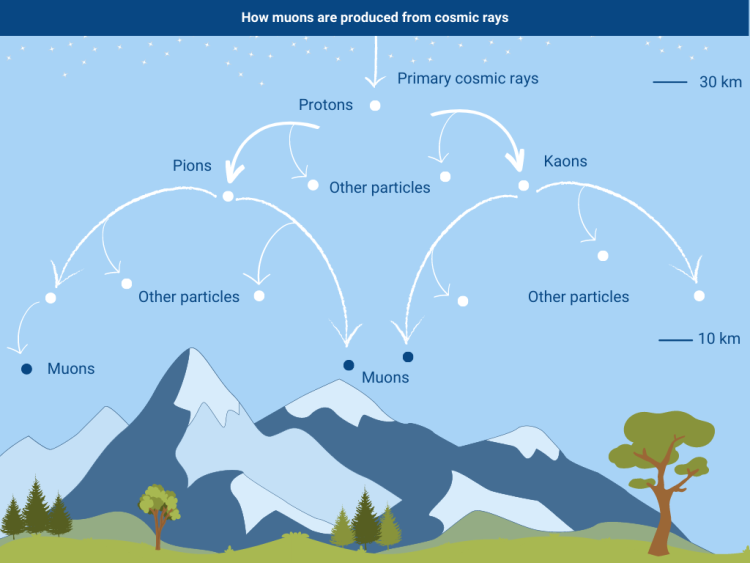I hope this post finds you in good spirits. I came across this article about muons and how scientist or using muons like x-rays. I'm sure you know about it, I didn't. I knew they were x-raying but not with muons. Now I took in consideration they don't know or understand the concept of ultimatons. But somehow they got muons to work for them.
Now this diagram at the bottom shows how muons are produce from cosmic rays.
Is this another way or, are they correct?
Muon Imaging: How Cosmic Rays Help Us See Inside Pyramids and Volcanoes
Artem Vlasov, IAEA Office of Public Information and Communication

A hidden corridor inside the Great Pyramid photographed by an endoscope. The existence of the corridor was first discovered using muography in 2016. (Photo: Egyptian Ministry of Tourism and Antiquities)
Last month, Egyptian officials revealed the first footage of a hidden corridor inside the 4 500-year-old Great Pyramid of Giza, located on the outskirts of Cairo. Nine metres long and two metres wide, the mysterious corridor was first detected in 2016 thanks to muon imaging. Muon imaging is a non-invasive technique which uses cosmic ray particles, called muons, to see inside solid objects, detecting changes in density and composition, and therefore enabling scientists to create 3D models of their interiors. A recent IAEA publication, Muon Imaging, focuses on how muons are used as a non-destructive testing tool, enabling experts to make accurate three-dimensional images of what lies inside large structures, from the outside.
What are muons?
Our universe is filled with countless cosmic rays that sweep through space at nearly the speed of light. They are emitted by the sun or come from supernova explosions in distant galaxies. Every second, the Earth is bombarded by these rays, consisting of trillions of sub-atomic particles. When cosmic rays collide with our atmosphere, some of them are deflected by the planet’s magnetic field, while others reach us here on Earth – without causing any harm. As the rays pass through the atmosphere, they undergo a series of reactions, creating a shower of new sub-atomic particles. Among these are muons.

Cosmic rays crash into the Earth's atmosphere, creating a stream of new particles, among them muons. (Graphic: A. Vlasov/IAEA)
Muons are puzzling, because some of their properties deviate, subtly but significantly, from the predictions of the leading theory of particle physics, known as the standard model. Yet scientists have found a way to use the mysterious particles, which resembles conventional radiography, to look deep inside large objects where physical access is not possible, such as ancient buildings, volcanoes or even nuclear reactors.
“Even though we can’t see them, muons are everywhere on Earth: they continuously pass through us and objects around us at almost the speed of light from all angles,†said Ian Swainson, a Nuclear Physicist at the IAEA. “They are completely harmless to people but can penetrate hundreds of metres of rock to provide a versatile means for understanding the composition and dimensions of materials which would otherwise be invisible to us.â€
“Muon imaging works in some sense like X-ray or gamma ray radiography, which is used in medicine to scan the body and in industry to assess the integrity and safety of structures and components,†added Andrea Giammanco, Particle Physicist and one of the authors of the new publication. “But while those types of radiography rely on intense artificial sources of radiation produced by particle accelerators or radioactive sources, muon radiography is based on cosmic rays that come naturally from outer space.â€
There are two general types of muon imaging: muography and muon scattering tomography (MST).
Muography involves placing a detector underneath or on the side of a structure to capture the muons passing through it. The denser the material, the more muons will be absorbed. Some of the particles that manage to traverse the structure will be caught by the detector on the opposite side. In the resulting image, empty spaces through which muons pass easily will be marked as bright spots, while materials with higher densities will be darker.
Whereas muography relies on the absorption of muons by materials, muon scattering tomography (MST) is based on how muons are scattered. For example, using two detectors positioned on two opposite sides of a car or a shipping container, experts can track how the particles are deflected from high-density materials with a high number of protons, making it possible to look inside the vehicle or the container without the need for physical inspection.
Muography. (Graphic: A. Vlasov/IAEA)
Muon Imaging: How Cosmic Rays Help Us See Inside Pyramids and Volcanoes | IAEAWeydevu
The IAEA’s new publication describes in detail the main techniques of muon